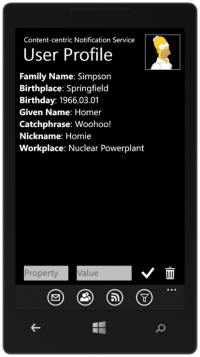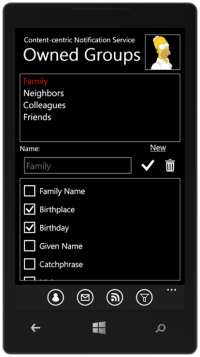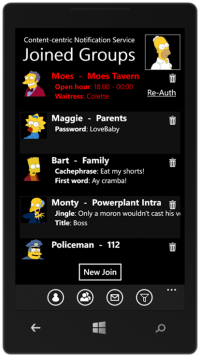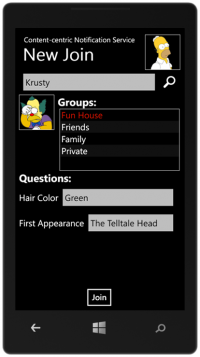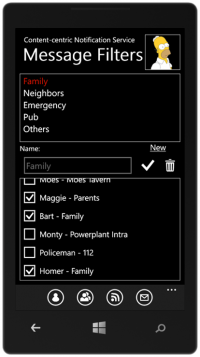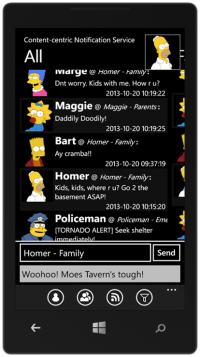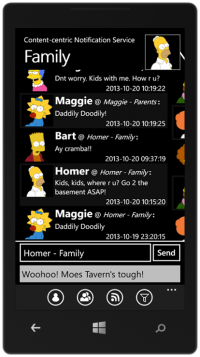Practical Course Advanced Networking (Winter 2014/2015): Difference between revisions
No edit summary |
|||
| Line 45: | Line 45: | ||
==Student Projects Demos== | ==Student Projects Demos== | ||
=== | ===Content-centric Notification System (CNS)=== | ||
A '''scalable''', '''secure''' and '''timely''' notification system is always a necessary in daily communication. It is especially important in a disaster scenario. E.g., the government will notify the citizens about the status of the recovery, rescue and supply. The victims also need to notify their relatives (and whoever cares about them) their current status. They can also call for help (from ambulance service or any responsible service provided by the government) via such notification systems. | A '''scalable''', '''secure''' and '''timely''' notification system is always a necessary in daily communication. It is especially important in a disaster scenario. E.g., the government will notify the citizens about the status of the recovery, rescue and supply. The victims also need to notify their relatives (and whoever cares about them) their current status. They can also call for help (from ambulance service or any responsible service provided by the government) via such notification systems. | ||
Revision as of 16:24, 8 September 2014
File:Example.jpg== Details ==
| Workload/ECTS Credits: | 180h, 6 ECTS |
| Module: | M.Inf.805.6C: Fortgeschrittenenpraktikum Computernetzwerke (6C), M.Inf.1800.Mp: Fortgeschrittenen Praktikum Computernetzwerke |
| Lecturer: | Dr. Xu Chen |
| Teaching assistant: | Mr. Lingjun Pu |
| Time: | TBD |
| Place: | IfI 3.101 |
| UniVZ | TBD |
Course description
In this semester, some of our offered projects are supported by Microsoft's Hawaii project. By choosing one of the projects marked by Hawaii, you are eligible to participate in the [1]. (500 US dollars will be awarded to the most competent team within our university.)
We have some project(s) demo here for previous semesters.
Prerequisites
You are highly recommended to have attended the following course(s) prior to this one:
- Computer Networks (previously "Telematik")
Organization
Informational meeting
At the beginning of this semester (see #Schedule), there is an informational meeting.
Course teams
Students conduct this course in small teams. A team consists of at most three students.
Passing requirements
- Present your topic and demonstrate your project at the end of this course (70%)
- Prepare a written report on the selected topic (12-15 pages, Template:[2]) (30%)
- It is mandatory for all students to stick to the deadlines mentioned in #Schedule.
Schedule
- TBD: Informational meeting
- Introduction to the course, selection of topics, formation of teams, and discussion of open questions
- TBD: Project mid-term presentation
- Give a presentation on the project topic, motivation and project plan
- Time limit: 15 min presentation + 10 min Q&A
- TBD: Project final presentation (Might change)
- Present and demonstrate your project, the motivation, the architecture, the program and the result
- Time limit: 25 min presentation (with demo) + 10 min Q&A
- 28 February 2015, 23:59: Submission of written report
Student Projects Demos
Content-centric Notification System (CNS)
A scalable, secure and timely notification system is always a necessary in daily communication. It is especially important in a disaster scenario. E.g., the government will notify the citizens about the status of the recovery, rescue and supply. The victims also need to notify their relatives (and whoever cares about them) their current status. They can also call for help (from ambulance service or any responsible service provided by the government) via such notification systems.
But the authorization is a big concern in such extreme scenarios. Authorization on a person-by-person basis is obviously not (energy, computation, and networkload) efficient. In such a system, we propose a new authorization system. A person create groups and use his own features (e.g., family name, cellphone number, eye color, etc.) as the challenge question for the group. In another word, he assumes that everyone who wants to join the group should have the knowledge of that information. Via such mechanism, a requester of a group can get authorization from other members of the group or even the network cache, thus save the cost on the group owner.
Another key feature of the project is the use of the Content-Centric Network (CCN). The new network architecture provides better support for a (topic-based) pub/sub system than the existing IP-based solutions. The demo system leverages the 6 machines in the network-lab running as CCN routers and hooks up with the HTTP translator on the edge of the network.
For more details, please check:
- Application definition of CNS: Media:CNSSlides.pdf.
- Architectural description of CNS: Media:CNSPoster.pdf.
- Demo abstract of CNS in ICNP 2013: Media:CNSPaper.pdf.
Topics
The following list of topics is constantly being expanded. If there is no topic that you like at the moment, please check back regularly for the most recent updates. You can also get in touch with us directly and we will try to find a topic that interests you. Also feel free to suggest your own topic(s) to the course advisors and we will accept it if the topic satisfies the requirements of this course.
| Topic | Topic advisor | Initial readings | Description | Student |
